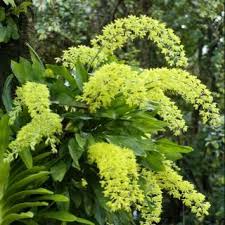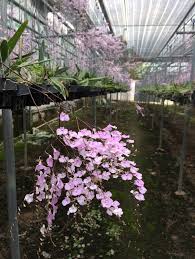
Oncidium orchids, commonly known as “dancing lady orchids,” are beloved for their stunning floral displays and graceful growth habits. To achieve the best results in terms of growth, health, and blooming, it is essential to provide these orchids with the right nutrients through effective fertilization. In this comprehensive guide, we will delve into the intricacies of selecting fertilizers for Oncidium orchids, exploring the types of fertilizers available, how to apply them, and tips for maintaining optimal growing conditions.
## Understanding the Nutritional Needs of Oncidium Orchids
Before diving into the types of fertilizers, it is crucial to understand the nutritional needs of Oncidium orchids. These orchids require a balanced supply of essential nutrients, including nitrogen (N), phosphorus (P), potassium (K), and various micronutrients, to thrive.
### 1. Essential Nutrients
– **Nitrogen (N)**: Vital for vegetative growth, nitrogen promotes the development of healthy leaves and stems. It’s especially important during the active growing season.
– **Phosphorus (P)**: Essential for root development, flowering, and overall plant vigor. Phosphorus encourages blooming and helps establish a robust root system.
– **Potassium (K)**: Important for overall plant health, potassium aids in water regulation, disease resistance, and the production of strong stems. It also enhances flower quality and longevity.
### 2. Micronutrients
Oncidium orchids also require several micronutrients in smaller amounts:
– **Calcium (Ca)**: Supports cell wall structure and is crucial for root health.
– **Magnesium (Mg)**: Essential for chlorophyll production and overall plant metabolism.
– **Iron (Fe)**: Vital for photosynthesis and enzyme function.
– **Manganese (Mn)**, **Zinc (Zn)**, **Copper (Cu)**, and **Boron (B)**: Important for various biochemical processes within the plant.
### 3. Growth Stages
Understanding the growth stages of Oncidium orchids can help determine their fertilization needs. The main growth phases are:
– **Active Growth Phase**: Typically occurs in spring and summer when the orchid is developing new growth and preparing to bloom. During this phase, orchids require higher levels of nitrogen to support leaf and stem growth.
– **Resting Phase**: Generally occurs in late fall and winter when the plant is not actively growing. During this time, the nutrient requirements decrease, and fertilization can be minimized.
## Types of Fertilizers for Oncidium Orchids
When choosing fertilizers for Oncidium orchids, you will encounter various types of products. Understanding these options can help you select the most suitable one for your plants.
### 1. Liquid Fertilizers
Liquid fertilizers are highly concentrated and provide immediate nutrient availability. They are ideal for quick feeding and can be mixed with water for application.
– **Application**: Dilute according to package instructions and apply during regular watering intervals, typically every 4 to 6 weeks during the growing season.
– **Benefits**: Fast-acting and easy to control; allows for precise nutrient delivery.
– **Considerations**: Over-fertilization can lead to salt buildup, so it’s essential to follow dosage guidelines.
### 2. Granular Fertilizers
Granular fertilizers provide a slow-release option that gradually releases nutrients over time. These fertilizers are often formulated for orchids and contain a balanced ratio of essential nutrients.
– **Application**: Sprinkle the recommended amount on the surface of the potting medium and water thoroughly to activate. Reapply every 6 to 8 weeks during the growing season.
– **Benefits**: Reduces the frequency of application; provides a steady nutrient supply.
– **Considerations**: May not provide immediate nutrient availability like liquid fertilizers.
### 3. Slow-Release Fertilizers
Slow-release fertilizers are specially formulated to release nutrients gradually over an extended period. They are ideal for busy gardeners who may not be able to fertilize frequently.
– **Application**: Incorporate the fertilizer into the potting medium at the beginning of the growing season. These fertilizers can last for several months.
– **Benefits**: Low maintenance; provides consistent nutrient release.
– **Considerations**: Ensure that the fertilizer is specifically designed for orchids to avoid nutrient imbalances.
### 4. Organic Fertilizers
Organic fertilizers are derived from natural sources and can be beneficial for orchids. These fertilizers improve soil health and provide a slow-release of nutrients.
– **Types**: Common organic options include compost, fish emulsion, and seaweed extracts.
– **Application**: Apply according to package instructions or mix into the potting medium. Organic fertilizers can often be used more liberally, but it’s still important to monitor for signs of nutrient deficiency.
– **Benefits**: Improves soil structure and microbial activity; environmentally friendly.
– **Considerations**: Nutrient content may vary, so consistency in application can be challenging.
## How to Choose the Right Fertilizer
Selecting the right fertilizer for your Oncidium orchids involves considering several factors. Here’s a step-by-step guide to help you make an informed decision.
### 1. Analyze Your Growing Conditions
Assess your growing environment, including light levels, temperature, humidity, and potting medium. These factors can influence the nutritional needs of your orchids.
– **Light Levels**: Orchids grown in brighter light may require more nutrients to support robust growth compared to those in lower light conditions.
– **Humidity**: High humidity levels can enhance nutrient absorption, while low humidity may require adjustments in fertilization frequency.
### 2. Determine Your Goals
Define what you want to achieve with your orchids. Are you focused on lush foliage growth, vibrant blooms, or overall plant health? Your goals will influence your fertilizer choice.
– **Foliage Growth**: If you want to encourage leaf growth, choose a fertilizer higher in nitrogen (e.g., a 30-10-10 ratio).
– **Blooming**: For promoting flowering, select a fertilizer with higher phosphorus levels (e.g., a 10-30-20 ratio).
### 3. Read the Labels
Carefully read the labels of fertilizers to understand their nutrient ratios and formulations. Look for products specifically formulated for orchids, as these will typically contain the right balance of nutrients.
– **N-P-K Ratio**: The three numbers on the fertilizer label indicate the percentage of nitrogen, phosphorus, and potassium. Choose a ratio that aligns with your goals.
– **Micronutrients**: Ensure the fertilizer contains essential micronutrients for optimal growth.
### 4. Consider Fertilizer Type
Decide on the type of fertilizer that suits your gardening style and the needs of your orchids. If you prefer hands-on care, liquid fertilizers may work well. For a more low-maintenance approach, consider slow-release or granular options.
### 5. Monitor Plant Health
After applying fertilizer, observe your orchids for signs of health or distress. Look for indicators such as leaf color, growth rate, and blooming patterns to determine if your fertilization strategy is effective.
– **Healthy Leaves**: Dark green leaves indicate adequate nitrogen levels, while yellowing leaves may suggest a deficiency.
– **Blooming**: Monitor blooming patterns to ensure that the fertilizer is supporting flower development.
## Applying Fertilizer to Oncidium Orchids
Proper application of fertilizers is just as important as choosing the right product. Here are some essential tips for applying fertilizers to your Oncidium orchids.
### 1. Timing of Application
– **Growing Season**: Apply fertilizers during the active growth period (spring and summer) when the plants are developing new growth and preparing to bloom.
– **Resting Phase**: Reduce or eliminate fertilization during the resting phase (fall and winter) to prevent nutrient buildup.
### 2. Watering Before Fertilizing
Always water your orchids thoroughly before applying fertilizers. This helps prevent root burn and ensures that nutrients are absorbed evenly.
– **Dry Medium**: If the potting medium is too dry, the roots may not effectively absorb the nutrients, leading to potential damage.
### 3. Dilution and Dosage
– **Follow Instructions**: Adhere to the manufacturer’s recommended dilution rates and application frequency to avoid over-fertilization.
– **Less is More**: If in doubt, it’s better to under-fertilize than to over-fertilize, as orchids are sensitive to nutrient imbalances.
### 4. Fertilizer Application Techniques
– **Liquid Fertilizers**: Mix the appropriate amount of fertilizer with water and apply it during regular watering sessions.
– **Granular Fertilizers**: Sprinkle the granules on the surface of the potting medium and water thoroughly to activate them.
– **Slow-Release Fertilizers**: Incorporate the granules into the potting medium at the beginning of the growing season.
### 5. Post-Fertilization Care
After fertilizing, continue to monitor your orchids for any signs of stress or improvement. Adjust your fertilization schedule as needed based on their responses.
## Common Mistakes to Avoid
When fertilizing Oncidium orchids, it’s essential to be aware of common mistakes that can harm your plants.
### 1. Over-Fertilization
One of the most significant mistakes is applying too much fertilizer, which can lead to salt buildup in the potting medium, root burn, and poor plant health.
### 2. Ignoring Watering Needs
Failing to water adequately before fertilizing can lead to nutrient absorption issues and potential root damage.
### 3. Choosing the Wrong Fertilizer
Using fertilizers not specifically designed for orchids can result in nutrient imbalances and poor growth.
### 4. Neglecting Micronutrients
Many gardeners focus solely on N-P-K ratios and overlook the importance of micronutrients, which are essential for overall plant health.
### 5. Not Monitoring Plant Health
Failing to observe and adjust care based on plant responses can
lead to ongoing issues and missed opportunities for improvement.
## Conclusion
Fertilizing Oncidium orchids is an essential aspect of their care and maintenance, ensuring healthy growth and vibrant blooms. By understanding the nutritional needs of these beautiful plants, selecting the appropriate fertilizers, and applying them correctly, you can enhance the beauty and health of your orchids. With patience and attention to detail, your Oncidium orchids will thrive, rewarding you with their stunning floral displays for years to come. Remember to monitor your plants regularly and adjust your fertilization strategy as needed, and you will enjoy the rewards of your dedicated care. Happy gardening!


